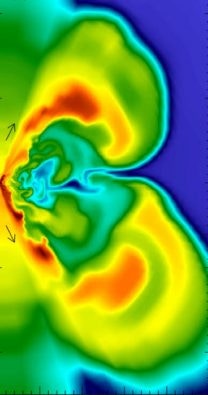MPS Awardee Spotlight: Eliot Quataert

Quataert’s work in theoretical astrophysics often intersects with the experimental and observational sides of the field. “In general, there is a very good interplay between people like me who do more theoretical work and the observational breakthroughs,” he says. “Theorists try to make predictions about what will be observed. Those predictions are often tested on relatively interesting time scales because there are lots of new telescopes being developed, both on the ground and with satellites. There’s a really rapid exchange between theory and observation, and certainly for me that makes it extremely exciting. There’s always new windows into looking into the universe that are coming out, that motivate thinking about new problems, or new observations to puzzle over.”
One of Quataert’s recent areas of research has been to predict the the properties of radiation produced during collisions between two neutron stars or between a neutron star and a black hole. He says, “The idea is to combine the information that you get from studying the gravitational waves with the information that you get from normal telescopes that are sensitive to optical light or X-rays, and the motivation for that is that they really provide very different information. The gravitational telescope tells you about how gravity was changing when the two objects collided, and the optical or X-ray telescope tells you about how the matter was behaving and how the light was produced.”

Credit: Rodrigo Fernandez & Eliot Quataert
Surprisingly, collisions between neutron stars may be a source of some of the rare heavy elements that are found on earth, such as gold and the “rare earth” elements used in devices from MRI magnets and cell phones to amplifiers in fiber-optic communication lines. Quataert says, “We’re not sure how these rare elements are produced in nature, but one of the best guesses is that they’re produced in collisions between neutron stars.” It may be possible to test that theory over the next few years through the use of gravitational and electromagnetic telescopes.
Quataert is a highly regarded teacher and public lecturer. “When I started at Berkeley, I discovered that I really enjoyed teaching,” he says. “It’s very different from research, but it keeps you fresh in terms of the research because it keeps you thinking about the big problems in the field. I think teaching is very useful for research in that respect. It gets you out of the narrow thing you’ve been worried about and reorients you.”
He gives several public talks a year and is inspired by his enthusiastic audiences. What is exciting, Quataert says, is “seeing how engaged and interested people are in the science and reminding people of why it is important to support basic science research — not only because it leads to technological innovations in the long run, but also because it starts to answer some very basic questions about where we come from, what our place in the universe is. People are really excited and engaged by those questions.”


